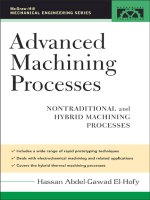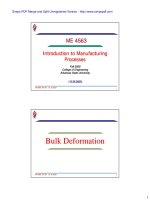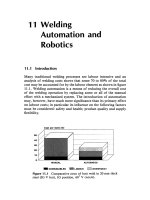Advanced Machining Processes potx
Bạn đang xem bản rút gọn của tài liệu. Xem và tải ngay bản đầy đủ của tài liệu tại đây (4.06 MB, 286 trang )
Advanced
Machining
Processes
This page is intentionally left blank.
Advanced
Machining
Processes
Nontraditional and Hybrid Machining Processes
Hassan El-Hofy
Production Engineering Department
Alexandria University, Egypt
McGraw-Hill
New York Chicago San Francisco Lisbon London Madrid
Mexico City Milan New Delhi San Juan Seoul
Singapore Sydney Toronto
Copyright © 2005 by The McGraw-Hill Companies. All rights reserved. Manufactured in the
United States of America. Except as permitted under the United States Copyright Act of 976,
no part of this publication may be reproduced or distributed in any form or by any means, or
stored in a database or retrieval system, without the prior written permission of the publisher.
0-07-146694-0
The material in this eBook also appears in the print version of this title: 0-07-145334-2.
All trademarks are trademarks of their respective owners. Rather than put a trademark symbol
after every occurrence of a trademarked name, we use names in an editorial fashion only, and
to the benefit of the trademark owner, with no intention of infringement of the trademark.
Where such designations appear in this book, they have been printed with initial caps.
McGraw-Hill eBooks are available at special quantity discounts to use as premiums and sales
promotions, or for use in corporate training programs. For more information, please contact
George Hoare, Special Sales, at or (212) 904-4069.
TERMS OF USE
This is a copyrighted work and The McGraw-Hill Companies, Inc. (“McGraw-Hill”) and its
licensors reserve all rights in and to the work. Use of this work is subject to these terms.
Except as permitted under the Copyright Act of 1976 and the right to store and retrieve one
copy of the work, you may not decompile, disassemble, reverse engineer, reproduce, modify,
create derivative works based upon, transmit, distribute, disseminate, sell, publish or
sublicense the work or any part of it without McGraw-Hill’s prior consent. You may use the
work for your own noncommercial and personal use; any other use of the work is strictly
prohibited. Your right to use the work may be terminated if you fail to comply with these
terms.
THE WORK IS PROVIDED “AS IS.” McGRAW-HILL AND ITS LICENSORS MAKE NO
GUARANTEES OR WARRANTIES AS TO THE ACCURACY, ADEQUACY OR
COMPLETENESS OF OR RESULTS TO BE OBTAINED FROM USING THE WORK,
INCLUDING ANY INFORMATION THAT CAN BE ACCESSED THROUGH THE
WORK VIA HYPERLINK OR OTHERWISE, AND EXPRESSLY DISCLAIM ANY
WARRANTY, EXPRESS OR IMPLIED, INCLUDING BUT NOT LIMITED TO IMPLIED
WARRANTIES OF MERCHANTABILITY OR FITNESS FOR A PARTICULAR
PURPOSE. McGraw-Hill and its licensors do not warrant or guarantee that the functions
contained in the work will meet your requirements or that its operation will be uninterrupted
or error free. Neither McGraw-Hill nor its licensors shall be liable to you or anyone else for
any inaccuracy, error or omission, regardless of cause, in the work or for any damages
resulting therefrom. McGraw-Hill has no responsibility for the content of any information
accessed through the work. Under no circumstances shall McGraw-Hill and/or its licensors be
liable for any indirect, incidental, special, punitive, consequential or similar damages that
result from the use of or inability to use the work, even if any of them has been advised of the
possibility of such damages. This limitation of liability shall apply to any claim or cause
whatsoever whether such claim or cause arises in contract, tort or otherwise.
DOI: 10.1036/0071466940
Dedicated to my wife Soaad El-Hofy
This page is intentionally left blank.
vii
Contents
Preface xi
Acknowledgments xvii
List of Acronyms xix
List of Symbols xxiii
Chapter 1. Material Removal Processes 1
1.1 Introduction 1
1.2 History of Machining 1
1.3 Traditional Machining 5
1.3.1 Machining by cutting 5
1.3.2 Machining by abrasion 6
1.4 Nontraditional Machining 8
1.4.1 Single-action nontraditional machining 9
1.4.2 Hybrid machining 10
References 13
Chapter 2. Mechanical Processes 15
2.1 Ultrasonic Machining 15
2.1.1 Introduction 15
2.1.2 The machining system 15
2.1.3 Material removal process 22
2.1.4 Factors affecting material removal rate 24
2.1.5 Dimensional accuracy and surface quality 26
2.1.6 Applications 28
2.2 Water Jet Machining 32
2.2.1 Introduction 32
2.2.2 The machining system 32
2.2.3 Process parameters 34
2.2.4 Applications 35
2.2.5 Advantages and disadvantages of WJM 38
2.3 Abrasive Jet Machining 39
2.3.1 Introduction 39
2.3.2 Machining system 39
2.3.3 Material removal rate 40
2.3.4 Applications 42
2.3.5 Advantages and limitations of AJM 42
vii
For more information about this title, click here
viii
2.4 Abrasive Water Jet Machining 43
2.4.1 Introduction 43
2.4.2 The machining system 44
2.4.3 Process capabilities 45
2.5 Ice Jet Machining 46
2.5.1 Introduction 46
2.5.2 Process description 46
2.6 Magnetic Abrasive Finishing 48
2.6.1 Introduction 48
2.6.2 The machining system 48
2.6.3 Material removal process 49
2.6.4 Applications 50
References 52
Chapter 3. Chemical Processes 55
3.1 Chemical Milling 55
3.1.1 Introduction 55
3.1.2 Tooling for CHM 57
3.1.3 Process parameters 61
3.1.4 Material removal rate 61
3.1.5 Accuracy and surface finish 62
3.1.6 Advantages 63
3.1.7 Limitations 64
3.1.8 Applications 64
3.2 Photochemical Milling 66
3.2.1 Introduction 66
3.2.2 Process description 66
3.2.3 Applications 67
3.2.4 Advantages 68
3.3 Electropolishing 70
3.3.1 Introduction 70
3.3.2 Process parameters 73
3.3.3 Applications 73
3.3.4 Process limitations 74
References 75
Chapter 4. Electrochemical Processes 77
4.1 Electrochemical Machining 77
4.1.1 Introduction 77
4.1.2 Principles of electrolysis 77
4.1.3 Theory of ECM 78
4.1.4 ECM equipment 79
4.1.5 Basic working principles 84
4.1.6 Process characteristics 87
4.1.7 Process control 95
4.1.8 Applications 97
4.1.9 Micro-ECM 98
4.1.10 Advantages and disadvantages of ECM 98
4.1.11 Environmental impacts 99
4.2 Electrochemical Drilling 100
4.3 Shaped Tube Electrolytic Machining 102
viii Contents
ix
4.4 Electrostream (Capillary) Drilling 105
4.5 Electrochemical Jet Drilling 108
4.6 Electrochemical Deburring 109
References 112
Chapter 5. Thermal Processes 115
5.1 Electrodischarge Machining 115
5.1.1 Introduction 115
5.1.2 Mechanism of material removal 115
5.1.3 The machining system 120
5.1.4 Material removal rates 125
5.1.5 Surface integrity 127
5.1.6 Heat-affected zone 129
5.1.7 Applications 130
5.1.8 Process control 137
5.1.9 EDM automation 138
5.1.10 Environmental impact 139
5.2 Laser Beam Machining 140
5.2.1 Introduction 140
5.2.2 Material removal mechanism 141
5.2.3 Applications 144
5.2.4 Advantages and limitations 156
5.3 Electron Beam Machining 157
5.3.1 Introduction 157
5.3.2 Basic equipment and removal mechanism 157
5.3.3 Applications 163
5.3.4 Advantages and disadvantages 165
5.4 Plasma Beam Machining 166
5.4.1 Introduction 166
5.4.2 Machining systems 166
5.4.3 Material removal rate 169
5.4.4 Accuracy and surface quality 169
5.4.5 Applications 171
5.4.6 Advantages and disadvantages 172
5.5 Ion Beam Machining 172
5.5.1 Introduction 172
5.5.2 Material removal rate 173
5.5.3 Accuracy and surface effects 175
5.5.4 Applications 176
References 177
Chapter 6. Hybrid Electrochemical Processes 181
6.1 Introduction 181
6.2 Electrochemical Grinding 182
6.2.1 Introduction 182
6.2.2 Material removal rate 183
6.2.3 Accuracy and surface quality 187
6.2.4 Applications 188
6.2.5 Advantages and disadvantages 188
6.3 Electrochemical Honing 189
6.3.1 Introduction 189
6.3.2 Process characteristics 189
Contents ix
6.3.3 Applications 191
6.4 Electrochemical Superfinishing 192
6.4.1 Introduction 192
6.4.2 Material removal process 193
6.4.3 Process accuracy 195
6.5 Electrochemical Buffing 196
6.5.1 Introduction 196
6.5.2 Material removal process 196
6.6 Ultrasonic-Assisted ECM 197
6.6.1 Introduction 197
6.6.2 Material removal process 198
6.7 Laser-Assisted ECM 199
References 201
Chapter 7. Hybrid Thermal Processes 203
7.1 Introduction 203
7.2 Electroerosion Dissolution Machining 204
7.3 Electrodischarge Grinding 212
7.4 Abrasive Electrodischarge Machining 216
7.5 EDM with Ultrasonic Assistance 218
7.6 Electrochemical Discharge Grinding 221
7.7 Brush Erosion-Dissolution Mechanical Machining 224
References 226
Chapter 8. Material Addition Processes 229
8.1 Introduction 229
8.2 Liquid-Based Techniques 230
8.2.1 Stereolithography 230
8.2.2 Holographic interference solidification 232
8.2.3 Beam interference solidification 232
8.2.4 Solid ground curing 233
8.2.5 Liquid thermal polymerization 235
8.2.6 Fused deposition modeling 235
8.2.7 Multijet modeling 238
8.2.8 Ballistic particles manufacturing 239
8.2.9 Shape deposition manufacturing 240
8.3 Powder-Based Processes 241
8.3.1 Selective laser sintering 241
8.3.2 Laser engineered net shaping 242
8.3.3 Three-dimensional printing 243
8.4 Solid-Based Techniques 244
8.4.1 Solid foil polymerization 244
8.4.2 Laminated object modeling 245
References 246
Index 249
x Contents
xi
Preface
Machining processes produce finished products with a high degree of
accuracy and surface quality. Conventional machining utilizes cutting
tools that must be harder than the workpiece material. The use of
difficult-to-cut materials encouraged efforts that led to the introduction
of the nonconventional machining processes that are well-established
in modern manufacturing industries.
Single-action nontraditional machining processes are classified on
the basis of the machining action causing the material removal from the
workpiece. For each process, the material removal mechanism, machin-
ing system components, process variables, technological characteristics,
and industrial applications are presented.
The need for higher machining productivity, product accuracy, and sur-
face quality led to the combination of two or more machining actions to
form a new hybrid machining process. Based on the major mechanism
causing the material removal process, two categories of hybrid machin-
ing processes are introduced. A review of the existing hybrid machining
processes is given together with current trends and research directions.
For each hybrid machining process the method of material removal,
machining system, process variables, and applications are discussed.
This book provides a comprehensive reference for nontraditional
machining processes as well as for the new hybrid machining ones. It is
intended to be used for degree and postgraduate courses in production,
mechanical, manufacturing, and industrial engineering. It is also useful
to engineers working in the field of advanced machining technologies.
In preparing the text, I paid adequate attention to presenting the
subject in a simple and easy to understand way. Diagrams are simple
and self-explanatory. I express my gratitude to all authors of various
books, papers, Internet sites, and other literature which have been
referred to in this book. I will be glad to receive comments and sugges-
tions for enhancing the value of this book in future editions.
Copyright © 2005 by The McGraw-Hill Companies, Inc. Click here for terms of use.
Outline of the book
The following subjects and chapters are organized as a journey toward
understanding the characteristics of nonconventional and hybrid
machining processes. The book is written in eight chapters:
Chapter 1: Material Removal Processes
Chapter 2: Mechanical Processes
Chapter 3: Chemical Processes
Chapter 4: Electrochemical Processes
Chapter 5: Thermal Processes
Chapter 6: Hybrid Electrochemical Processes
Chapter 7: Hybrid Thermal Processes
Chapter 8: Material Addition Processes
In Chap. 1, the history and progress of machining is introduced. The
difference between traditional and nontraditional machining is explained.
Examples for conventional machining by cutting and abrasion are given.
Single-action nontraditional machining is classified according to the
source of energy causing the material removal process. Hybrid machin-
ing occurs as a result of combining two or more machining phases.
Hybrid machining is categorized according to the main material removal
mechanism occurring during machining.
Chapter 2 covers a wide range of mechanical nontraditional machin-
ing processes such as ultrasonic machining (USM), water jet machin-
ing (WJM), abrasive water jet machining (AWJM), ice jet machining
(IJM), as well as magnetic abrasive finishing (MAF). In these processes
the mechanical energy is used to force the abrasives, water jets, and ice
jets that cause mechanical abrasion (MA) to the workpiece material.
In Chap. 3, the chemical machining processes such as chemical milling
(CHM), photochemical machining (PCM), and electrolytic polishing (EP)
are discussed. In these processes the material is mainly removed
through chemical dissolution (CD) occurring at certain locations of the
workpiece surface.
Chapter 4 deals with electrochemical machining (ECM) and related
applications that include electrochemical drilling (ECDR), shaped tube
electrolytic machining (STEM), electrostream (ES), electrochemical jet
drilling (ECJD), and electrochemical deburring (ECB). The electro-
chemical dissolution (ECD) controls the rate of material removal.
Machining processes that are based on the thermal machining action
are described in Chap. 5. These include electrodischarge machining
(EDM), laser beam machining (LBM), electron beam machining (EBM),
plasma beam machining (BPM), and ion beam machining (IBM). In most
xii Preface
Preface xiii
of these processes, material is removed from the workpiece by melting
and evaporation. Thermal properties of the machined parts affect the
rate of material removal.
Hybrid electrochemical machining processes are dealt with in Chap. 6.
Some of these processes are mainly electrochemical with mechanical
assistance using mechanical abrasion such as electrochemical grinding
(ECG), electrochemical honing (ECH), electrochemical superfinishing
(ECS), and electrochemical buffing (ECB). The introduction of ultrasonic
assistance enhances the electrochemical dissolution action during
ultrasonic-assisted ECM (USMEC). Laser beams activate electro-
chemical reactions and hence the rate of material removal during laser-
assisted electrochemical machining (ECML).
Chapter 7 covers the hybrid thermal machining processes. Electro-
chemical dissolution (ECD) enhances the electrodischarge erosion action
(EDE) during electroerosion dissolution machining (EEDM). Mechanical
abrasion encourages the thermal erosion process during electrodischarge
grinding (EDG) and abrasive-assisted electrodischarge machining
(AEDG and AEDM). Ultrasonic assistance encourages the discharging
process during ultrasonic-assisted EDM (EDMUS). Triple-action hybrid
machining occurs by combining both electrochemical dissolution (ECD)
and mechanical abrasion to the main erosion phase during electro-
chemical discharge grinding (ECDG).
Material addition processes are covered in Chap. 8. These include a
wide range of rapid prototyping techniques that are mainly classified
as liquid-, powder-, and solid-based techniques.
Advantages of the book
1. Covers both the nonconventional and hybrid machining processes
2. Classifies the nonconventional machining processes on the basis of
the machining phase causing the material removal (mechanical, ther-
mal, chemical, and electrochemical processes)
3. Classifies the hybrid machining processes based on the major mech-
anism and hence the machining phase causing the material removal
from the workpiece into hybrid thermal and hybrid electrochemical
processes
4. Presents clearly the principles of material removal mechanisms in
nonconventional machining as well as hybrid machining
5. Explains the role of each machining phase (causing the material
removal) on the process behavior
6. Describes the machining systems, their main components, and how
they work
7. Discusses the role of machining variables on the technological charac-
teristics of each process (removal rate, accuracy, and surface quality)
8. Introduces the material addition processes that use the same prin-
ciples adopted in material removal by nonconventional processes
This book is intended to help
1. Undergraduates enrolled in production, industrial, manufacturing,
and mechanical engineering programs
2. Postgraduates and researchers trying to understand the theories of
material removal by the modern machining processes
3. Engineers and high-level technicians working in the area of advanced
machining industries
Why did I write the book?
This book presents 28 years of experience including research and teach-
ing of modern machining methods at many universities around the
world. My career started early in the academic year 1975–1976 through
a senior project related to the effect of some parameters on the oversize
of holes produced by ECM. Afterward, I finished my M.S. degree in the
field of accuracy of products by electrolytic sinking in the Department
of Production Engineering at Alexandria University. As an assistant
lecturer I helped to teach about conventional and nonconventional
machining.
I spent 4 years on a study leave in the U.K. working toward my Ph.D.
at Aberdeen University and 1 year at Edinburgh University. During
that time I finished my thesis in the field of hybrid electrochemical
arc wire machining (ECAM) under the supervision of Professor
J. McGeough. That work was supported by the Wolfson Foundation
and the British Technology Group. I had the Overseas Research Student
(ORS) award for three successive years which supported me during my
research work. Working on a large research team and sharing discus-
sions in regular meetings, I gained more experience related to many
advanced and hybrid machining applications such as hybrid ECM-EDM,
ECAM drilling, and electrochemical cusp removal. I was a regular steer-
ing committee member for the CAPE conference organized by Professor
McGeough. I edited two chapters and shared in the writing of chapter 1
of his book Micromachining of Engineering Materials.
Throughout my academic career in which I started out as a lecturer
and moved up to being a full professor of modern machining processes,
I have taught all subjects related to machining in many universities
around the world. I have published about 50 research papers related to
xivxiv Preface
nonconventional as well as hybrid machining processes. During my
work in Qatar University I was responsible for teaching the advanced
machining techniques course. Collecting all materials that I had in a
book therefore came to my mind. I have been working on this task since
the year 2001.
Hassan El-Hofy
Alexandria, Egypt
xvPreface xv
This page is intentionally left blank.
Acknowledgments
There are many people who have contributed to the development of this
book that I cannot name. First of all, I would like to thank Professors
H. Youssef and M. H. Ahmed at the University of Alexandria, Egypt,
Professors H. Rahmatallh, S. Soliman and O. Saad at the University of
Qatar for their support, suggestions and encouragement.
The editorial and production staff at McGraw Hill have my heartfelt
gratitude for their efforts in ensuring that the text is accurate and as
well designed as possible.
My greatest thanks have to be reserved to my wife Soaad and
daughters Noha, Assmaa, and Lina for their support and interest
throughout the preparation of the text. Special thanks have to be offered
to my son Mohamed for his discussions, suggestions, and the splendid
artwork in many parts of the book.
It is with great pleasure that I acknowledge the help of many organ-
izations that gave me permission to reproduce numerous illustrations
and photographs in this book:
■
Acu-Line Corporation, Seattle, WA
■
ASM International, Materials Park, OH
■
ASME International, New York, NY
■
Extrude Hone, Irwin, PA
■
IEE, Stevenage, UK
■
Jet Cut Incorporation, Waterloo, ON, Canada
■
Jet-Edge, St. Michael, MN
■
LCSM-EFPL, Swiss Federal Institute of Technology, Lausanne,
Switzerland
■
Precision Engineering Journal, Elsevier, Oxford, UK
■
TU/e, Eindhoven University of Technology, Netherlands
■
Vectron Deburring, Elyria, OH
xvii
Copyright © 2005 by The McGraw-Hill Companies, Inc. Click here for terms of use.
This page is intentionally left blank.
List of Acronyms
Abbreviation Description
AEDG Abrasive electrodischarge grinding
AEDM Abrasive electrodischarge machining
AFM Abrasive flow machining
AJM Abrasive jet machining
AWJM Abrasive water jet machining
BHN Brinell hardness number
BIS Beam interference solidification
BEDMM Brush erosion dissolution mechanical machining
BPM Ballistic particles manufacturing
C Cutting
CAD Computer-aided design
CAM Computer-aided manufacturing
CAPP Computer-assisted process planning
CBN Cubic boron nitride
CD Chemical dissolution
CHM Chemical milling
CIM Computer-integrated manufacturing
CVD Carbon vapor deposition
CNC Computer numerical control
CW Continuous wave
EBM Electron beam machining
ECAM Electrochemical arc machining
ECB Electrochemical buffing
ECD Electrochemical dissolution
ECDB Electrochemical deburring
ECDG Electrochemical discharge grinding
xix
Copyright © 2005 by The McGraw-Hill Companies, Inc. Click here for terms of use.
Abbreviation Description
ECDM Electrochemical discharge machining
ECDR Electrochemical drilling
ECG Electrochemical grinding
ECH Electrochemical honing
ECJD Electrochemical jet drilling
ECM Electrochemical machining
ECML Laser-assisted electrochemical machining
ECS Electrochemical superfinishing
EDE Electrodischarge erosion
EDG Electrodischarge grinding
EDM Electrodischarge machining
EDMUS Electrodischarge machining with ultrasonic assistance
EDT Electrodischarge texturing
EEDM Electroerosion dissolution machining
EP Electropolishing
ES Electrostream
FDM Fused deposition modeling
FJ Fluid jet
G Grinding
HAZ Heat-affected zone
HF Hone forming
HIS Holographic interference solidification
IBM Ion beam machining
IJM Ice jet machining
LAE Laser-assisted chemical etching
LAJECM Laser-assisted jet ECM
LAN Local area network
LBM Laser beam machining
LBT Laser beam texturing
LENS Laser engineered net shaping
LOM Laminated object modeling
LTP Liquid thermal polymerization
MA Mechanical abrasion
MAF Magnetic abrasive finishing
MJM Multijet modeling
MMC Metal matrix composites
MPEDM Mechanical pulse electrodischarge machining
xx List of Acronyms
Abbreviation Description
MRR Material removal rate
MS Mechanical scrubbing
MUSM Micro-ultrasonic machining
NC Numerical control
ND-YAG Neodymium-doped yitrium-aluminum-garnet
PAM Plasma arc machining
PBM Plasma beam machining
PCB Photochemical blanking
PCD Polycrystalline diamond
PECM Pulse electrochemical machining
PF Photoforming
PCM Photochemical milling
PM Pulsed mode
RP Rapid prototyping
RUM Rotary ultrasonic machining
SB Shot blasting
SDM Shape deposition manufacturing
SFF Solid free-form fabrication
SFP Solid foil polymerization
SGC Solid ground curing
SLA Stereolithography
SLS Selective laser sintering
STEM Shaped tube electrolytic machining
TEM Thermal energy method
US Ultrasonic
USM Ultrasonic machining
USMEC Ultrasonic-assisted electrochemical machining
VRR Volumetric removal rate
WJM Water jet machining
List of Acronyms xxi
This page is intentionally left blank.
List of Symbols
Symbol Definition Unit
a tool feed rate mm/min
A atomic weight
A/Z chemical equivalent g
A/Z.F electrochemical equivalent g/C
A
b
area of laser beam at focal point mm
2
C electrochemical machining constant mm
2
/s
C/y
e
metal removal rate per unit area mm/min
C
d
diametrical overcut mm
C
l
constant depending on material and
conversion efficiency
C
s
speed of sound in magnetostrictor material m/s
d CHM undercut mm
D EDM depth mm
D/L
c
corner wear ratio mm
D/L
e
end wear ratio
D/L
s
side wear ratio
d/T etch factor
d
a
mean diameter of abrasive particles µm
d
b
beam diameter at contact with
workpiece (slot width) mm
d
s
spot size diameter mm
d
t
tool diameter mm
d
w
produced hole diameter mm
dy/dt workpiece rate of change of position mm/min
E Young’s modulus MPa
⑀
m
coefficient of magnetostriction elongation
xxiii
Copyright © 2005 by The McGraw-Hill Companies, Inc. Click here for terms of use.
Symbol Definition Unit
E
m
magnitudes of magnetic energy
e
v
number of pulses
E
v
vaporization energy of material W/mm
3
E
w
magnitudes of mechanical energy
F frequency of oscillation Hz
f frequency of changes in magnetic field Hz
F Faraday’s constant C/g per-ion
F
l
focal length of lens cm
f
p
frequency of pulses Hz
f
r
resonance frequency Hz
g depth of hole required
g
e
depth of hole removed per pulse mm
g
w
wheel-workpiece gap
h thickness of material mm
H magnetic field intensity
H
0
surface fracture strength BHN
H
rms
surface roughness µm
H
w
hardness of workpiece material N/mm
2
i EDM current A
I electrolyzing current A
I
e
beam emission current mA
I
p
pulse current A
J current density A/mm
–2
K constant
K
h
constant µm/µJ
K
m
coefficient of magnetomechanical coupling
K
p
coefficient of loss
l original length of magnetostrictor
L slot length mm
L
c
corner wear mm
L
e
end wear mm
L
p
laser power W
L
s
side wear mm
m amount of mass dissolved g
n density of target material atoms per cm
3
n
e
number of pulses
N number of abrasives impacting per unit area
xxiv List of Symbols









